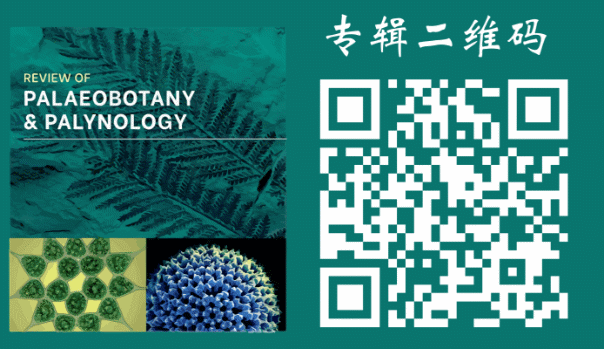化石花粉记录对于重建过去的植物种类、植被和生物地理历史具有重要意义。近几十年来,人们对整个新生代植物多样性的了解越来越深入,这在很大程度上归功于孢粉学数据的分类学分辨率的提高,特别是在花粉多样性高的亚热带-热带地区,其中,花粉数据库的发展和系统孢粉学的新技术应用进一步加深了对过去花粉多样性、植被历史和分布变迁的理解,以及推动这些变化的因素。
中国科学院南京地质古生物研究所研究员毛礼米、中山大学教授黄康有与副教授黄华生在国际SCI期刊《古植物学与孢粉学评论》(Review of Palaeobotany and Palynology)上组织的专辑《新生代以来亚热带-热带地区的花粉多样性、植被历史和分布变迁》(Pollen diversity, vegetation history and range shift in the (sub)tropics through the Cenozoic)于近期出版。
该专辑主要汇编了以下领域的最新研究成果:1、系统孢粉学,重点介绍了高分辨率显微镜、机器学习和化学分类学等最新方法;2、长时间尺度的植被历史;3、时空分布变迁,主要关注亚热带-热带地区,包括全球或区域范围内植被动态的变化速率、人类影响、基于化石花粉记录的新生代生态重要树种的分布变迁。
本专辑的论文分别探讨了整个新生代亚热带-热带地区的花粉多样性、植被历史和分布变迁,可细分为五个研究主题:1、花粉多样性:从传统形态学研究(Dai et al., 2023; Huang et al., 2023; Wei et al., 2023; Parmar et al., 2023; Robin-Champigneul et al., 2023; Mao et al., 2024)到孢粉素的化学分析(Hu et al., 2023)和机器学习的应用(Zhang et al., 2024);2、花粉粒3D打印的推广和教育项目(Wilson, 2023);3、化石花粉记录的应用研究,涉及到重建古气候、古生物地理学和孢粉地层学的意义(Huang et al., 2023; Korasidis et al., 2023; Parmar et al., 2023; Robin-Champigneul et al., 2023; Mao et al., 2024; Yang et al., 2024);4、第四纪花粉分析中花粉统计量的理论分析(Weng & Hooghiemstra, 2024);5、 植被历史和植物分布变迁 (Robin-Champigneul et al., 2023; Chen et al., 2024; Ge et al., 2024; Mao et al., 2024; Yang et al., 2024)。专辑总结文章中还指出了未来的孢粉学研究应进一步关注化学分类学、沉积古 DNA (sedaDNA) 以及机器学习在现代和化石花粉分析中的应用等(Mao et al., 2024. Editorial)。
专辑链接:https://www.sciencedirect.com/special-issue/10GQ26L33TB
专辑介绍(Editorial):https://doi.org/10.1016/j.revpalbo.2024.105277
14篇专辑论文序号与列表(序号对应于插图中的标号):
- Wei, C.X., Jardine, P.E., Gosling, W.D., Hoorn, C., 2023. Is Poaceae pollen size a useful proxy in palaeoecological studies? New insights from a Poaceae pollen morphological study in the Amazon. Review of Palaeobotany and Palynology 308, 104790.
- Huang, H.S., Morley, R.J., van der Ham, R., Mao, L.M., Licht, A., Dupont-Nivet, G., Win, Z., Aung, D.W., Hoorn, C., 2023. Grimmipollis burmanica gen. et sp. nov.: New genus of the soapberry family (Sapindaceae) from the late Eocene of central Myanmar. Review of Palaeobotany and Palynology 309, 104818.
- Wilson, O.J., 2023. The 3D Pollen Project: An open repository of three-dimensional data for outreach, education and research. Review of Palaeobotany and Palynology 312, 104860.
- Korasidis, V.A., Wallace, M.W., Chang, T.-J., Phillips, D., 2023. Eocene paleoclimate and young mountain-building in the Australian Eastern Highlands. Review of Palaeobotany and Palynology 312, 104875.
- Parmar, S., Morley, R.J., Bansal, M., Singh, B.P., Morley, H., Prasad, V., 2023. Evolution of family Arecaceae on the Indian Plate modulated by the Early Palaeogene climate and tectonics. Review of Palaeobotany and Palynology 313, 104890.
- Robin-Champigneul, F., Gravendyck, J., Huang, H., Woutersen, A., Pocknall, D., Meijer, N., Dupont-Nivet, G., Erkens, R.H.J., Hoorn, C., 2023. Northward expansion of the southern-temperate podocarp forest during the early Eocene: Palynological evidence from the NE Tibetan Plateau (China). Review of Palaeobotany and Palynology 316, 104914.
- Dai, L., Zhang, Q.Y., Foong, S.Y., Cheng, Z.J., Weng, C.Y., Mao, L.M., 2023. Pollen morphology of selected tropical plants in Peninsular Malaysia and its implication in the paleoecological reconstruction of Southeast Asia. Review of Palaeobotany and Palynology 316, 104935.
- Hu, Z.Z., Jia, X.L., Chen, X., Yang, Z.N., Mao, L.M., Xue, J.S., 2023. Fluorescence lifetime imaging of sporopollenin: An alternative way to improve taxonomic level of identifying dispersed pollen and spores. Review of Palaeobotany and Palynology 316, 104946.
- Mao, L.M., Chen, X.J., Wang, Y.H., Liang, Y.-S., Zhou, Y.F., 2024. Parrotia (Hamamelidaceae) pollen morphology and a glimpse into the fossil record and historical biogeography. Review of Palaeobotany and Palynology 324, 105038.
- Ge, J.L., Shu, J.W., Mao, L.M., Han, X.Y., Cheng, Y., 2024. Revealing early Neolithic vegetation and environmental changes in the Lower Yangtze Valley, eastern China: Pollen insights. Review of Palaeobotany and Palynology 323, 105060.
- Chen, C.Z., Li, H., Wei, L.S., Ji, Y., Wu, S.Q., Xu, Q., Zhao, W.W., Zhang, X.J., Zhao, Y., 2024. Rate of vegetation change in southeast China during the Holocene and its potential drivers. Review of Palaeobotany and Palynology 322, 105066.
- Yang, Y., Wang, W.M., Shu, J.W., Chen, W., Shi, G.L., 2024. Pollen-based Miocene vegetation history from the Fotan Formation, SE China and its palaeoclimatic and palaeoenvironmental significances. Review of Palaeobotany and Palynology 323, 105078.
- Weng, C.Y., Hooghiemstra, H., 2024. How many pollen grains should we count? – A basic statistical view. Review of Palaeobotany and Palynology 330, 105126.
- Zhang, S.J., Mao, L.M., Lai, Y.J., 2024. Reevaluation of pollen differentiation in Altingiaceae: Challenges in distinguishing deciduous (Liquidambar) and evergreen (Altingia) types using multivariate statistics and machine learning. Review of Palaeobotany and Palynology 331, 105209.

Review of Palaeobotany and Palynology期刊封面及专辑二维码

插图:(A) 14篇专辑论文的研究地点和/或采样地点的地理分布概览,并配有二维码(扫码可查看论文/花粉动画/3D花粉数据储存库),以及选定的部分论文中的现代和化石花粉类型(论文序号1-3、5、6、9、14);(B) 欧洲区(3.Wilson,2023,14. Zhang et al.,2024);(C) 南美洲区(1. Wei et al.,2023,地图 C 中实心紫色圆圈内的地点)和北美洲区(14. Zhang et al.,2024); (D) 亚洲区(2. Huang et al., 2023, 5. Parmar et al., 2023, 6. Robin-Champigneul et al., 2023, 7. Dai et al., 2023, 8. Hu et al., 2023, 9. Mao et al., 2024, 10. Ge et al., 2024, 11. Chen et al.,2024,12. Yang et al.,2024,13. Weng & Hooghiemstra,2024,14. Zhang et al., 2024)和澳大利亚(4. Korasidis et al.,2023)。论文序号与发表顺序相对应。仅有一篇论文(14. Zhang et al., 2024)的采样点(地图 B-D 中的实心粉红色圆圈)来自不同大洲(欧亚大陆、美洲和澳大利亚)。地图 B-D 中还显示了论文的核心关键词。赤道由地图 A 中心的虚线表示。
附件下载:
